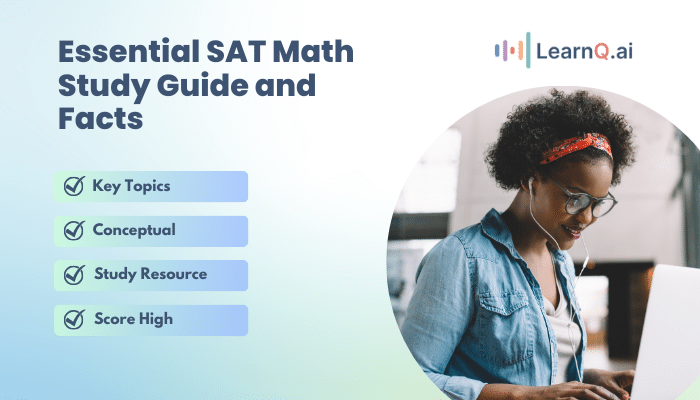You’re probably curious about what the digital SAT Math section has in store for you. Well, it’s a blend of tradition and innovation, where the basic mathematical concepts remain the core of it. Still, the exams are now on computers powered by useful tools.
This blog has been crafted to evaluate your understanding of mathematical concepts, your ability to apply them, and your problem-solving prowess, all in a digital format.
You’ll encounter a variety of questions ranging from algebra and geometry to more advanced topics like trigonometry and data analysis. The digital format adds a new dimension to the test, allowing for a more dynamic and interactive experience.
It’s not just about knowing the formulas; it’s about using technology to enhance your problem-solving skills. You can learn all the aspects of SAT math from the SAT math notes brief shared below;
Importance of Digital SAT Math for College Admissions
Now, you might wonder, “Why is digital SAT Math crucial for college admissions?” We have jotted down the answers for you:
- Assessment of Readiness: Digital SAT Math evaluates your preparedness for college-level math, reflecting modern academic demands.
- Demonstration of Adaptability: Scoring well shows your ability to thrive in digital learning contexts, an increasingly vital skill in higher education.
- Evidence of Potential: High performance indicates your capability to succeed in rigorous, tech-centric academic courses.
- Mathematical Ability Display: It’s not just about crunching numbers; it’s about problem-solving with precision in a digital format.
- Tech Proficiency: Excelling in digital SAT Math highlights your proficiency with digital tools, a skill that colleges value.
- Advantage in Admissions: A solid score can give you an edge in the competitive college admissions process, proving you’re ready for the future of education.
Outline of the Digital SAT Math Section Including Categories
So, what exactly can you expect in the digital SAT Math section? The digital SAT Math notes unfold over two modules, each offering 22 questions to tackle in 35 minutes. In total, you’re presented with 70 minutes of problem-solving that culminates in 44 questions designed to gauge your mathematical acumen.
| Modules | Time Given | Total No. of Questions |
| Module 1 | 35 minutes | 22 questions |
| Module 2 | 35 minutes | 22 questions |
| Total | 70 minutes | 44 questions. |
The digital format allows for a more interactive and intuitive testing experience. The questions are categorized into four main areas:
- Algebra- 35% (13-14 questions)
- Advance math- 35% (13-14 questions)
- Problem-solving and Data analysis- 15% (5-7 questions)
- Geometry and trigonometry- 15% (5-7 questions)
Now, let’s try to understand all these above sections in detail. So, let’s get started!
Heart of Algebra
This part provides an overview of SAT math formulae by covering algebra and function concepts, which serve as the foundation for many exam questions.
Key Topics Overview
In Heart of Algebra, you’ll get into the foundational concepts that form the basis of algebra. This SAT math notes section is all about understanding the relationships between variables, mastering the art of simplification, solving linear, and quadratic equations, and much more!
It’s a journey through the core principles that will prepare you for more advanced mathematical challenges.
- Simplifying Expressions with PEMDAS
One of the first steps in mastering algebra is learning to simplify expressions. Enter PEMDAS, the order of operations: Parentheses, Exponents, Multiplication, and Division (from left to right), and Addition and Subtraction (from left to right).
This rule is your guide to breaking down complex expressions into simpler forms. It’s not just about following steps; it’s about developing a systematic approach to simplification.
PEMDAS stands for
- Parentheses First, check what’s inside the brackets.
- Exponents Secondly, solve powers and roots before.
- Multiplication and Division (from left to right) Now, solve these operations in the order they appear.
- Addition and Subtraction (from left to right) Lastly, perform these operations.
- Forms of Linear Equations for Graphing
Linear equations can be expressed in various forms, each with its advantages for graphing.
The Slope-Intercept Form (y = mx + b) highlights the slope and y-intercept, making it easy to graph a line quickly.
The Slope Formula
is essential for finding the slope between two points.
The Standard Form (ax + by = c) is useful for analyzing equations and solving systems of linear equations.
Understanding these forms is key to visualizing and interpreting linear relationships.
- Interpreting Linear Equations
Finally, interpreting linear equations is about understanding the story they tell. It’s not just about finding solutions; it’s about analyzing the slope and y-intercept to understand the rate of change and the starting point of a line.
Whether you’re dealing with a positive or negative slope or a horizontal or vertical line, each equation offers insights into the relationship between variables. It’s about seeing the bigger picture and applying these concepts to real-world scenarios.
Below, we have shared a few images of the algebra section questions that you can easily find in the full-length test offered by LearnQ.ai.
Problem Solving and Data Analysis
This part provides an overview of SAT math formulae by covering problem-solving and data analysis concepts.
Key Topics Overview
In the case of Problem Solving and Data Analysis, numbers tell stories and data holds the answers. This section is all about interpreting information, making sense of data, and solving real-world problems.
You’ll explore topics like ratios, rates, proportions, and percentages, and delve into the world of statistics and data representation. It’s a journey through the practical side of math, where every number has a purpose. So, let’s investigate in detail below.
- Ratios, Rates, and Unit Rates
Ratios and rates are the building blocks of problem-solving. They help you compare quantities and understand relationships. A ratio compares two quantities, while a rate is a ratio that compares two quantities with different units.
Unit rates, a special type of rate, tell you how much of one quantity corresponds to one unit of another quantity. Mastering these concepts is key to analyzing real-world situations.
- Density as a Unit Rate and Proportions
Density is a perfect example of a unit rate in action. It’s the ratio of mass to volume, telling you how much mass is packed into a given volume. Understanding density helps you grasp the concept of proportions, which are equations that express the equality of two ratios. Proportions are essential for scaling quantities up or down and maintaining relationships between variables.
- Unit Conversions and Percentages
Unit conversions and percentages are tools that help you navigate the world of measurements and comparisons. Whether you’re converting units of length, volume, or mass, it’s all about finding equivalent values.
Percentages, on the other hand, are a way to express ratios as fractions of 100. They’re crucial for comparing proportions, calculating discounts, and understanding statistical data.
- Scatterplots, Best-fit Lines, and Modeling Data
Scatterplots are a visual representation of data, showing the relationship between two variables. By plotting points on a graph, you can observe patterns and trends.
Best-fit lines, or lines of best-fit, are straight lines that approximate the data points as closely as possible. They’re used for modeling data and making predictions, a key aspect of data analysis.
- Association in Data, Table Data, and Statistics Basics
Understanding the association in data is about recognizing relationships and correlations. Table data, presented in rows and columns, is a structured way to organize and analyze information.
The basics of statistics, including measures of central tendency and variability, provide a foundation for interpreting data. It’s all about drawing meaningful conclusions and making informed decisions based on data.
Below, we have shared a few images of the problem-solving and data analysis section questions that you can easily find in the full-length test offered by LearnQ.ai. It will give you an idea of the above-discussed concepts.
Passport to Advanced Mathematics
This part provides an overview of SAT math formulae by covering advanced mathematics concepts.
Key Topics Overview
Embark on a journey through the Passport to Advanced Mathematics, where you’ll dive deeper into the world of algebra and explore more complex mathematical concepts.
This section is all about pushing the boundaries of your understanding, from polynomials and quadratic equations to exponential functions and rational expressions. It’s a gateway to higher-level math, preparing you for the challenges of college courses and beyond.
- Polynomials and Polynomial Factors and Zeros
Polynomials are expressions made up of variables and coefficients, combined using addition, subtraction, multiplication, and non-negative integer exponents. Understanding polynomials involves identifying their factors and zeros.
Factors are expressions that multiply together to form the polynomial, while zeros are the values of the variable that make the polynomial equal to zero. These concepts are crucial for simplifying expressions and solving equations.
- Quadratic Equations and Linear and Quadratic Systems
Quadratic equations are a central topic in advanced mathematics.
They take the form of
and can be solved using various methods, including factoring, completing the square, and the quadratic formula.
Linear and quadratic systems involve solving equations that contain both linear and quadratic components. These systems require a combination of algebraic and graphical techniques to find the points of intersection.
- Exponential Equations, Rules of Exponents, and Radicals
Exponential equations involve variables in the exponent, presenting unique challenges in solving them. The rules of exponents, such as the product rule and the power rule, are essential tools for simplifying exponential expressions.
Radicals, or expressions involving roots, add another layer of complexity. Understanding how to manipulate and solve equations with exponents and radicals is key to mastering advanced mathematics.
- Rational Expressions and Rational Equations
Rational expressions are fractions that involve polynomials in the numerator and denominator. Simplifying these expressions and solving rational equations require a solid grasp of factoring and common denominators. These concepts are vital for working with ratios, rates, and proportions in more complex scenarios.
- Function Notation Extended
Function notation is a way of representing functions that emphasizes the input-output relationship.
In advanced mathematics, function notation is extended to include more complex functions, such as quadratic functions, exponential functions, and rational functions.
Understanding this notation is crucial for analyzing and graphing functions, as well as for solving real-world problems.
Below, we have shared a few images of the advanced math section questions that you can easily find in the full-length test offered by LearnQ.ai. Give it a try, and try to clear all your concepts.
Geometry and Trigonometry
This part provides an overview of SAT math formulae by covering advanced mathematics concepts.
Key Topics Overview
Welcome to the exploration of geometry and trigonometry section in Math, where you’ll venture beyond the core concepts and dive into the fascinating world of geometry, trigonometry, and complex numbers.
This section is all about expanding your mathematical horizons, from understanding shapes and angles to navigating the complex plane. It’s a journey through the diverse landscape of mathematics, where every concept adds a new dimension to your understanding.
- Geometry Overview and Key Formulas
Geometry is the study of shapes and their properties. It’s a realm filled with lines, angles, circles, and polygons, each governed by its own set of rules and formulas.
Key formulas in geometry include the area and perimeter of various shapes, the Pythagorean theorem, and the formulas for the volumes of solids.
Understanding these formulas is essential for solving geometric problems and interpreting spatial relationships.
- Angle Relationships and Proportional Shapes
Angles are a fundamental aspect of geometry, and their relationships are crucial for analyzing shapes and solving problems. Complementary and supplementary angles, vertical angles, and angles formed by parallel lines and transversals are just a few examples.
Proportional shapes, such as similar triangles and figures, rely on the concept of proportionality to maintain their shape while scaling in size. These concepts are key to understanding the geometry of the world around us.
- Triangle Theorems and Properties
Triangles are perhaps the most studied shapes in geometry, and for good reason. They are the building blocks of many geometric structures and are rich in properties and theorems.
The Triangle Sum Theorem, the Pythagorean Theorem, and the properties of special triangles like equilateral and isosceles triangles are all essential for solving triangle-related problems. These theorems and properties provide a foundation for exploring more complex geometric concepts.
- Radians and Degrees, and Graphed Circles
When it comes to measuring angles, radians and degrees are the two units you’ll encounter. Radians provide a natural way to measure angles based on the radius of a circle, while degrees are more commonly used in everyday contexts.
Understanding the relationship between these units is crucial for working with trigonometric functions and analyzing graphed circles. Circles, with their properties of circumference and area, play a central role in both geometry and trigonometry.
- Complex Numbers
Complex numbers are an extension of the real number system, where every number has a real part and an imaginary part. They are essential for solving equations that have no real solutions, such as x2 + 1 = 0.
Complex numbers also have geometric interpretations and are used in many areas of mathematics and engineering. Understanding complex numbers opens the door to a world of mathematical possibilities.
Below, we have shared a few images of the geometry and trigonometry section questions that you can easily find in the full-length test offered by LearnQ.ai. You can always leverage these practice tests to upgrade your SAT prep.
Want to read more about SAT Math formulas? Read this blog!
Digital SAT Math Study Resources
Suggestion to Take Practice Tests for an Estimated Score
One of the best ways to prepare for the Digital SAT Math section is to take practice tests. These tests provide a realistic experience of the actual exam and can give you an estimated score.
By taking these practice tests, you can identify your strengths and weaknesses, familiarize yourself with the format and types of questions, and build your confidence. It’s a crucial step in your preparation journey.
List of SAT Math Resources for Further Study
To further your study and deepen your understanding of SAT Math concepts, here’s a list of resources you might find helpful:
- LearnQ.ai: At LearnQ.ai, interactive learning meets AI-driven quizzes to bolster your math mastery.
- Prep Scholar: Tailors a full spectrum of online prep including custom study plans, authentic SAT practice, and insightful feedback.
- College Board’s Official SAT Study Guide: Provides official practice tests and detailed explanations of each question.
- The Princeton Review: Offers comprehensive prep books and online courses with strategies and practice questions.
- Barron’s SAT Math Workbook: Contains extensive practice questions and review material.
Integrating practice tests into your study routine has several benefits:
- Familiarity: Regular practice helps you become familiar with the exam format and question types.
- Time Management: You can improve your time management skills, by learning to allocate time efficiently across different sections.
- Stress Reduction: By simulating the test environment, you can reduce anxiety and stress on the actual test day.
- Performance Tracking: You can track your progress over time, identifying areas of improvement and adjusting your study plan accordingly.
Conclusion
In conclusion, while each of the resources listed provides a robust platform for SAT Math preparation, LearnQ.ai stands out as a particularly innovative solution. This platform harnesses the power of AI to offer personalized SAT math notes that can enhance your learning experience.
With LearnQ.ai, you don’t just practice SAT Math; you engage with it in a way that’s tailored to your learning style and pace. Its features not only prepare you for the SAT but also cultivate a deeper appreciation and understanding of math. Choose LearnQ for a focused, efficient, and interactive path to math mastery that’s as unique as you are.











